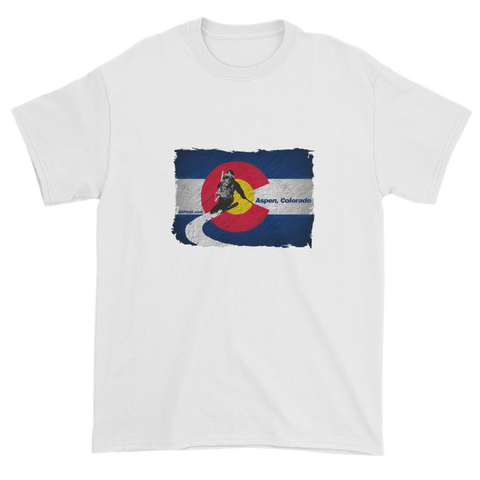My buddy Jim called and needed a photo of his 8k ski ring. His home was broken into, and they took his ring. This ring is a memento we ( The Aspen Alpine Club, Inc.) started giving to north Americans who skied from 8,000 meters. Only criteria, you have to carry your skis and can't use supplemental oxygen. It's not a big list:
Mike & Steve Marolt, Shishapangma 2000
Laura Bakos Cho Oyu, 2000
Kris Erickson Cho Oyu, 2000
Mark Newcomb Shishapangma, 2005
Kent McBride Shishapangma 2005
Mike & Steve Marolt Cho Oyu, 2007
Jim Gile Cho Oyu, 2007
Tyler Johnson Cho Oyu 2007
Rory Stark Cho Oyu 2007
Michael Aasheim and Daniel McCann skied Cho Oyu in 2005, but we have never been able to get in touch with them. (If anyone knows these guys, please have them contact us at 8kpeak.com)
Upon reflection of this list and the sport in general, it's fairly surprising in my view that the list is basically from an era pre super light technology. There are about a dozen North Americans who have climbed and skied from above 8,000 meters post 2007, but they did not fit the criteria which is a more pure form. I think that along with the light weight technology in AT ski gear, the environment of mountaineering in general has just changed. Along with the improvements of AT ski gear, all gear has evolved including supplemental oxygen equipment. A quick lookback is interesting.
Back in 2000, oxygen systems failed constantly and were almost more of a hassle than anything. It was extremely expensive, and a typical scenario was for a climber to reach base camp, be given a set amount of oxygen, with directions on where to start using it and at specific low flows. If a climber used it beyond those directions, they ran out and were subject to the chatter of “cheating”. I know for me personally, I simply never considered using oxygen, enhanced by the reality that it failed often, but was so prohibitively expensive, it was not even remotely possible. I never used it, and while the photos in books of extreme mountaineers clad in face masks at altitude was incredibly macho, what was lost in translation was those pioneer climbers were so backed into a corner with antiquated gear otherwise, they probably could not have climbed those peaks back then without it. By 1978, however, with drastic improvements in lighter gear, Messner and Habler proved it could be done when they topped out on Everest without supplemental oxygen.
By 2010, oxygen systems had improved drastically and the commercialism of mountaineering began to take advantage of the technology. Masses could now use supplemental oxygen and apparently climb to the highest summits more easily and safely. More meant the industry could grow, and along with it, the acceptable means employed. Today, oxygen systems have quadrupled the flow of oxygen, and with Sherpa available to carry the gas, it has become more acceptable and even ethical to use it.
Looking at the list of North American ski mountaineers who have taken on the highest peaks without oxygen, and then comparing it to those that subsequently used oxygen, it is not a surprise that the list of pure ski descents has drastically declined. Looking at the total list of ski descents from above 8,000 meters worldwide, after 2010, roughly 90% of all 8k ski descents have been with the aid of supplemental oxygen.
Regardless, the notion of climbing and skiing the highest peaks is an extremely difficult proposition with or without, however, for the few that maintain the purer approach, the memento is available. This will be administered by the team at 8kpeak. The ring is pure silver, and comes at a cost 8kpeak will cover. The larger cost, however, is doing what it takes to get one. So please, climb and ski high, and let us know about your adventure. And regardless of means, hats off to everyone that takes the skis. It’s a monumental task; carrying the gear decreases your chances of a summit substantially, it entails a tremendous amount of extra effort, and mentally, just taking the skis to try is something that those who have been there appreciate and understand.




Mike Marolt
Michael, Sorry for the delay in getting back to your posts. Congratulations and will add you to the list. There are no record keepers of this stuff, so it’s beyond cool when people reach out and let us know so we can at least track the players. I’ll send you an email and crank up the ring cast.
Michael Aasheim
I’ll elaborate a bit on when Dan McCann and I skied from 8000 meters on Cho Oyu. We made it to the start of the summit plateau at 8100 meters and our climbing mate Bill started displaying severe symptoms of high altitude pulmonary edema. The summit plateau of Cho Oyu is a still a pretty long walk at 8200 meters to get to the true summit. We opted to get Bill off the mountain. Dan and I put on our skies at 8100 meters and skied down making sure that Bill was descending at a good pace.
Although we missed the summit by 100 meters we still successfully skied from over 8000 meters without supplemental oxygen.
Michael Aasheim
Yes, Dan McCann and I did ski from 8000 meters on Cho Oyu without supplemental oxygen in 2005. We also skied the yellow band and the ice falls without rope assist. It was fun knowing that we were some of the early pioneers in 8000 meter skiing.